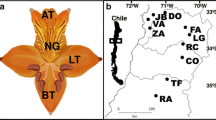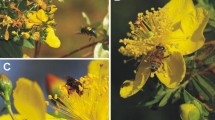Abstract
Floral orientation may affect pollinator attraction and pollination effectiveness, and its influences may differ among pollinator species. We, therefore, hypothesized that, for plant species with a generalized pollination system, changes in floral orientation would affect the composition of pollinators and their relative contribution to pollination. Geranium refractum, an alpine plant with downward floral orientation was used in this study. We created upward-facing flowers by altering the flower angle. We compared the pollinator diversity, pollination effectiveness, and pollinator importance, as well as female reproductive success between flowers with downward- and upward-facing orientation. Results indicated that the upward-facing flowers were visited by a wider spectrum of pollinators (classified into functional groups), with higher pollinator diversity than natural flowers. Moreover, due to influences on visitation number and pollen removal, the pollinator importance exhibited by the main pollinator groups differed between flower types. Compared with natural flowers, the pollination contribution of principal pollinators (i.e., bumblebees) decreased in upward-facing flowers and other infrequent pollinators, such as solitary bees and muscoid flies, removed more pollen. Consequently, stigmatic pollen loads were lower in upward- than in downward-facing flowers. These findings reveal that floral orientation may affect the level of generalization of a pollination system and the relative importance of diverse pollinators. In this species, the natural downward-facing floral orientation may increase pollen transfer by effective pollinators and reduce interference by inferior pollinators.



Similar content being viewed by others
References
Ågren J, Willson MF (1992) Determinants of seed production in Geranium maculatum. Oecologia 92:177–182
Aizen MA (2003) Down-facing flowers, hummingbirds and rain. Taxon 52:675–680
Armbruster WS (1988) Multilevel comparative analysis of the morphology, function, and evolution of Dalechampia blossoms. Ecology 69:1746–1761
Asikainen E, Mutikainen P (2005) Preferences of pollinators and herbivores in gynodioecious Geranium sylvaticum. Ann Bot 95:879–886
Callaway RM (1995) Positive interactions among plants. Bot Rev 61:306–349
Castellanos MC, Wilson P, Thomson JD (2004) ‘Anti-bee’ and ‘pro-bird’ changes during the evolution of hummingbird pollination in Penstemon flowers. J Evol Biol 17:876–885
Cruden RW (1977) Pollen-ovule ratios: a conservative indicator of breeding systems in flowering plants. Evolution 31:32–46
Faegri K, Van der Pijl L (1979) The principles of pollination ecology. Pergamon Press, Oxford
Fenster CB, Armbruster WS, Wilson P, Dudash MR, Thomson JD (2004) Pollination syndromes and floral specialization. Annu Rev Ecol Evol Syst 35:375–403
Fenster CB, Armbruster WS, Dudash MR (2009) Specialization of flowers: is floral orientation an overlooked first step? New Phytol 183:502–506
Fulton M, Hodges SA (1999) Floral isolation between Aquilegia formosa and Aquilegia pubescens. Proc R Soc Lond B 266:2247–2252
Galen C, Stanton ML (2003) Sunny-side up: flower heliotropism as a source of parental environmental effects on pollen quality and performance in the snow buttercup, Ranunculus adoneus (Ranunculaceae). Am J Bot 90:724–729
Galloni M, Podda L, Vivarelli D, Quaranta M, Cristofolini G (2008) Visitor diversity and pollinator specialization in Mediterranean legumes. Flora 203:94–102
Hocking B, Sarplin CD (1965) Flower basking by arctic insects. Nature 206:215
Hodges SA, Whittall JB, Fulton M, Yang JY (2002) Genetics of floral traits influencing reproductive isolation between Aquilegia formosa and Aquilegia pubescens. Am Nat 159:S51–S60
Huang SQ, Takahashi Y, Dafni A (2002) Why does the flower stalk of Pulsatilla cernua (Ranunculaceae) bend during anthesis? Am J Bot 89:1599–1603
Kandori I (2002) Diverse visitors with various pollinator importance and temporal change in the important pollinators of Geranium thunbergii (Geraniaceae). Ecol Res 17:283–294
Kevan PG (1975) Sun-tracking solar furnaces in high arctic flowers: significance for pollination and insects. Science 189:723–726
Kevan PG, Baker HG (1983) Insects as flower visitors and pollinators. Annu Rev Entomol 28:407–453
Kobayashi S, Inoue K, Kato M (1997) Evidence of pollen transfer efficiency as the natural selection factor favoring a large corolla of Campanula punctata pollinated by Bombus diversus. Oecologia 111:535–542
Kudo G (1995) Ecological significance of flower heliotropism in the spring ephemeral Adonis ramosa (Ranunculaceae). Oikos 72:14–20
Larsson M (2005) Higher pollinator effectiveness by specialist than generalist flower-visitors of unspecialized Knautia arvensis (Dipsacaceae). Oecologia 146:394–403
Lázaro A, Lundgren R, Totland Ø (2009) Co-flowering neighbors influence the diversity and identity of pollinator groups visiting plant species. Oikos 118:691–702
Mahoro S (2003) Effects of flower and seed predators and pollinators on fruit production in two sequentially flowering congeners. Plant Ecol 166:37–48
Neal PR, Dafni A, Giurfa M (1998) Floral symmetry and its role in plant-pollinator systems: terminology, distribution, and hypotheses. Annu Rev Ecol Syst 29:345–373
Patiño S, Jeffree C, Grace J (2002) The ecological role of orientation in tropical convolvulaceous flowers. Oecologia 130:373–379
Sapir N, Dudley R (2013) Implications of floral orientation for flight kinematics and metabolic expenditure of hover-feeding hummingbirds. Funct Ecol 27:227–235
Schemske DW, Bradshaw H (1999) Pollinator preference and the evolution of floral traits in monkeyflowers (Mimulus). Proc Nat Acad Sci 96:11910–11915
Schemske DW, Horvitz CC (1984) Variation among floral visitors in pollination ability: a precondition for mutualism specialization. Science 225:519–521
Simpson EH (1949) Measurement of diversity. Nature 163:688
Smith AP (1975) Insect Pollination and Helioptropism in Oritrophium limnophilum (Compositae) of the Andean Páramo. Biotropica 7:284–286
Sprengel CK (1793) Das entdeckte geheimnis der natur im bau und in der befruchtung der blumen. Verlag Wilhelm Engelmann, Leipzig
Stang M, Klinkhamer PGL, Van Der Meijden E (2006) Size constraints and flower abundance determine the number of interactions in a plant–flower visitor web. Oikos 112:111–121
Straw RM (1956) Adaptive morphology of the Penstemon flower. Phytomorphology 6:112–119
Tadey M, Aizen MA (2001) Why do flowers of a hummingbird-pollinated mistletoe face down? Funct Ecol 15:782–790
Ushimaru A, Hyodo F (2005) Why do bilaterally symmetrical flowers orient vertically? Flower orientation influences pollinator landing behavior. Evol Ecol Res 7:151–160
Ushimaru A, Kawase D, Imamura A (2006) Flowers adaptively face down-slope in 10 forest-floor herbs. Funct Ecol 20:585–591
Ushimaru A, Dohzono I, Takami Y, Hyodo F (2009) Flower orientation enhances pollen transfer in bilaterally symmetrical flowers. Oecologia 160:667–674
Van Etten ML, Prevost LB, Deen AC, Ortiz BV, Donovan LA, Chang SM (2008) Gender differences in reproductive and physiological traits in a gynodioecious species, Geranium maculatum (Geraniaceae). Int J Plant Sci 169:271–279
Wang Y, Meng LL, Yang YP, Duan YW (2010) Change in floral orientation in Anisodus luridus (Solanaceae) protects pollen grains and facilitates development of fertilized ovules. Am J Bot 97:1618–1624
Wang H, Tie S, Yu D, Guo Y-H, Yang C-F (2014) Change of floral orientation within an inflorescence affects pollinator behavior and pollination efficiency in a bee-pollinated plant, Corydalis sheareri. Plos One 9:e95381
Willson MF, Miller LJ, Rathcke BJ (1979) Floral display in Phlox and Geranium: adaptive aspects. Evolution 33:52–63
Wilson P, Thomson JD (1991) Heterogeneity among floral visitors leads to discordance between removal and deposition of pollen. Ecology 72:1503–1507
Wu ZY, Raven PH and Hong DY (2008) Flora of China. Science Press, Beijing and Missouri Botanical Garden Press, St. Louis, pp 8–28
Young HJ (1988) Differential importance of beetle species pollinating Dieffenbachia longispatha (Araceae). Ecology 69:832–844
Acknowledgments
We thank two anonymous reviewers for their detailed and constructive comments, Xue-Gang Zhu and Shuang Tie for their help in field work, Xiao-Xia Li, Kuo Liao and Charles B. Fenster for the helpful comments and suggestions. This study was supported by grants from the National Natural Science Foundation of China (31170214 to YHG and 31070206 to CFY).
Author information
Authors and Affiliations
Corresponding authors
Additional information
Communicated by M. Lawes.
Rights and permissions
About this article
Cite this article
Wang, H., Xiao, CL., Gituru, R.W. et al. Change of floral orientation affects pollinator diversity and their relative importance in an alpine plant with generalized pollination system, Geranium refractum (Geraniaceae). Plant Ecol 215, 1211–1219 (2014). https://doi.org/10.1007/s11258-014-0379-y
Received:
Accepted:
Published:
Issue Date:
DOI: https://doi.org/10.1007/s11258-014-0379-y




